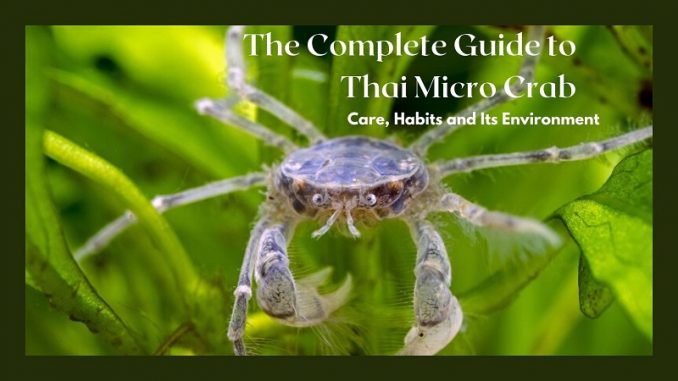
Thai micro crabs, also called false spider crabs, are only found in one river in Thailand. Because they are only found in one place and are so tiny, they’re an exotic and unique addition to your varied aquarium or a shrimp habitat.
Thai micro crabs are super adaptable and one of the only fully aquatic crab species in the world. They get the false spider crab name from their very long legs in comparison to their tiny carapace (hardshell).
These tiny creatures are slightly challenging to care for as they are completely defenseless and need high water quality.
If you’re interested in adding some variety to your tank, you’ve come to the right place to find out everything you need to know about Thai micro crabs, which have quickly gained popularity among aquarium hobbyists.
TABLE OF CONTENTS
Thai Micro Crab Facts & Overview

| Category | Rating |
| Care Level: | Medium |
| Temperament: | Peaceful |
| Color: | Light grey with patterns |
| Lifespan: | 1-1.5 years |
| Size: | .4 inch |
| Diet: | Omnivore/Detritivore |
| Family: | Hymenosomatidae |
| Minimum Tank Size: | 5 gallons |
| Tank Set-Up: | Freshwater with plants and wood |
| Compatibility: | Peaceful community |
The scientific name for the Thai micro crab is Limnopilos naiyanetri. In addition to false spider crabs, these tiny aquatic crabs are also known as pill-box crabs.
Due to the fact that these crabs are a relatively new discovery and are only found in one river in Thailand, it can be a challenge to find these peaceful beings online or in pet stores.
The Thai micro crab originates from the Tha Chin River, which is in the Nakhon Pathom Province of Thailand, and they live in the roots of the water plant hyacinth.
The Limnopilos genus is part of the Hymenosomatidae family and was first described in the scientific world back in 1991, so it’s new to the aquarium scene. It was equated with the Hymenicoides briefly but after scientists discovered some distinguishing traits, was classified once again with the Limnopilos genus.
Because they are so small, they are often prey to larger, aggressive animals and fish. They will rarely prey on other creatures, save for minuscule baby shrimplets and snails. Even your aquarium plants are safe with them, even though the Thai micro crab is without defense in your tank.
The Thai micro crab can be injured very easily, even getting caught in your filter (babies, especially, can get sucked up into the filter) or losing legs when you use a net with them. To avoid the babies getting sucked up by the filter, you can use a pre-filter sponge to protect the little ones.
As we alluded to before, the Thai micro crabs resemble spiders because their legs are so long in relation to the size of their bodies. But even with the long legs, micro describes them well – they are really tiny! The adult Thai micro crab maxes out at .5 inches, with a patterned transparent grey-silver color. The Thai micro crab, a scavenger, is covered with tiny hairs that help them grab food particles.
Because of their tiny composition, they fit well in nano tanks and small tanks.
Typical Behavior
When you first introduce your new Thai micro crabs to your aquarium, you’ll find that they are shy and introverted. They like to have places to hide, even after they feel more comfortable in their environment. They’ll be happy if you put some plants and caves in the tank so they can conceal themselves when they want to.
They are also nocturnal creatures, so you won’t see much of them during the day. Consider investing in a glow light bulb so you can get a glimpse of them at night. When they do adapt to their new home, you’ll be able to see them chilling on the driftwood you’ve set up for them or hanging out on the plants in the tank.
Appearance
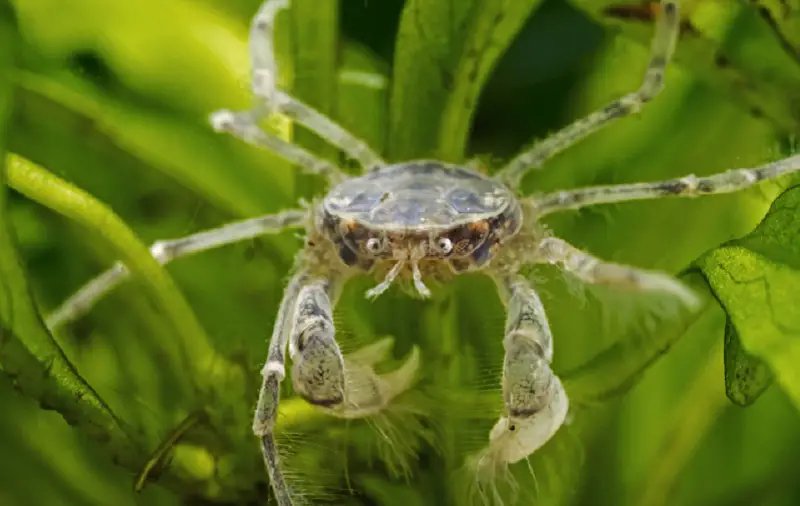
Thai micro crabs are translucent grey and silver or brown, and their legs are beige-like. Sometimes they have a pattern on their carapace (hardshell).
These micro crabs are equipped with 10 legs, which they usually tuck underneath themselves. As we mentioned before, those very long legs (relatively speaking, of course) are covered with hairy bristles, as are the rest of their bodies, a feature that aids in food collection.
The Thai Micro Crab, All Grown Up
In its adult state, the Thai micro crab’s carapace measures in at a little less than half an inch wide. Those “long” legs we’ve been talking about are about an inch long shell (carapace width) is only around 1 cm long (less than half an inch). If you think that sounds really small, you’re right. This species is the smallest known freshwater crab.
Molting
Like other crab species, Thai micro crabs molt. However, due to their compact size and because they grow very slowly, they do not molt as often.
The process, however, is similar to the molting process of other crabs.
The molting activity commences with the Thai micro crab filling its carapace with water, which helps separate the crab’s exoskeleton. The pressure of the water also cracks the exoskeleton open. As a new carapace forms, the Thai micro crab pops out from under the old one.
The Thai micro crab will look translucent after molting since it is still water heavy and soft. The hardening happens over the course of three days or so. Don’t be surprised if you find the old skeleton on the floor of your aquarium.
The already defenseless crab is even more vulnerable during the molting time. It’s a good idea to delay any cleaning until after your crab finishes molting to prevent any injury or added stress to this tiny creature. Molting is not the time to go Marie Kondo on your aquarium.
Habitat and Tank Conditions
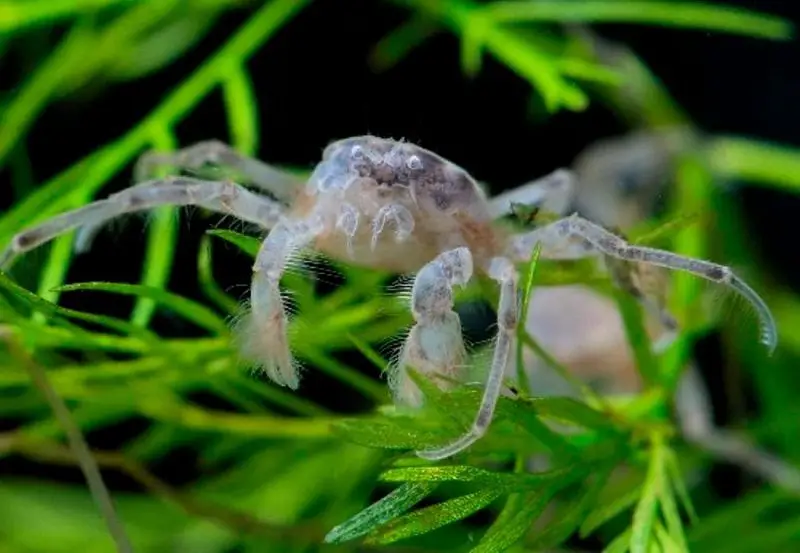
You should cycle the water in the aquarium before adding your Thai micro crabs, and make sure the tank is matured. You can mature a new aquarium by incorporating ⅓ of the water from an already matured tank into new water, or from several other accepted methods.
Failure to fully and carefully acclimate Thai micro crabs to their new environment can be fatal.
You should check water levels often and also change the water regularly, also keeping an eye out for good bubbling on the tank surface.
Tank Conditions
The recommended water temperature range for Thai micro crabs is 72-82 degrees F (22-28 degrees C) and the minimum tank size is 2 gallons. However, depending on what else you have in your aquarium, you might want a 5-gallon tank, which would fit a colony of half a dozen quite well.
The best pH level is 6.5 to 8.0 and the water hardness should be between 6-15 dKH.
After making sure you have high-quality water conditions and a quality filter, you want to make sure that you have lots of plants (especially floating ones!), caves, wood, and other decorations to make your Thai micro crabs feel cozy and have the greatest hiding spots. Since they like to hide, you might want to choose colors that contrast the color of your Thai micro crab – that way, you’ll be sure to see them.
In addition to the floating vegetation, good choices for plants for the Thai micro crabs include ferns, anubias, and mosses; the long roots on these plants simulate the hyacinth in their native environment.
Tank Mates
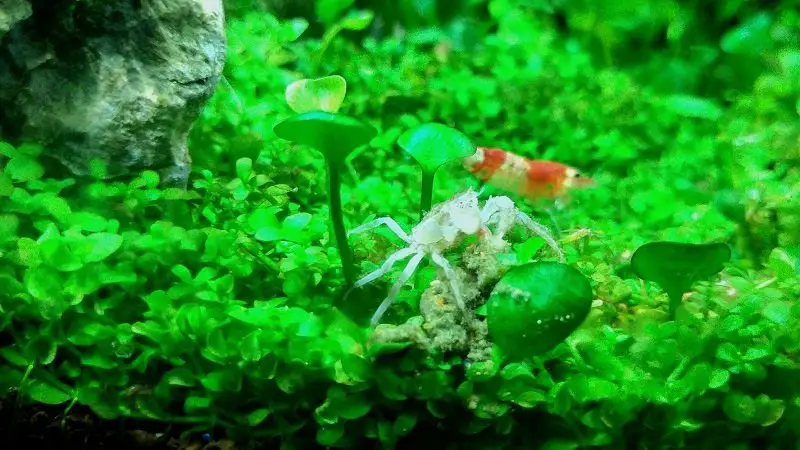
The Thai micro crab really needs a peaceful environment because it’s so tiny and has absolutely no way to defend itself from aggressive predators. Thai micro crabs thrive when they live together in groups of 5 or 6 – it makes them feel more secure.
They can also be paired with small schools of fish, mellow fish like a Pygmy Corydoras, Otocinclus catfish, or Zebra Danio, and small shrimp and snails.
Definitely avoid pairing Thai micro crabs in a tank with other kinds of crabs, who will surely have them for dinner. Other poor choices for your Thai micro crab community include crayfish and other aggressive fish, such as Cichlids.
Good tankmates
- Small schooling fish
- Ramshorn Snails
- Otocinclus catfish
- Nerite Snails
- Zebra Danio
- Ghost Shrimp
- Pygmy Corydoras
- Mystery Snails
- Neocaridina shrimp
Poor tank mates
Diet
As we discussed in the appearance section, Thai micro crabs are covered in bristly hairs so that they can filter water through them as they are scavenging for food – they will eat the particles from plant roots and algae. They are omnivores and detritivores (organisms that eat dead matter), so they are not too picky about what they eat.
Shrimp food and sinking pellets are good supplements for Thai micro crabs, and in addition to the particles they get from plant roots, they will forage in mosses and algae.
Thai micro crabs eat the particles that get stuck in their bristles as they clean themselves. It’s good to remember that the Thai micro crab is not aggressive and therefore does not hunt for its food; rather, it will eat whatever it can find.
If you have a new aquarium that does not have a lot of biofilm and decay, your Thai micro crab would appreciate some plant-based dry food, blanched veggies, and algae wafers.
If you’re managing a mature aquarium, you may not need to supplement the diet of your Thai micro crab group, as there is likely ample food for them to scavenge. If you have Dwarf shrimp, however, the crabs will lose the race to the food.
Care
Thai micro crabs are agreeable and social creatures; they prefer being in groups with other Thai micro crabs. They differ from some other crab species that are more territorial and sometimes the males will fight.
Thai micro crabs get along peacefully with each other and hang out in shared hiding places. A good way to care for your Thai micro crabs is to make sure they have a community of 5 or 6.
Thai Micro crabs enjoy currents from their natural river environment, so if you are able to add a small powerhead to your aquarium to create some water flow in the tank, you will have some content crabs that can stay active.
Thai Micro Crab Lifespan
Because the Thai micro crab has only been studied for the past 30 years or so, there is not a lot of information about their lifespan in the river. But in a controlled aquarium environment, you can expect a Thai micro crab to live for a year to a year and a half. If you care for them well, they could last even longer.
Breeding
So far, aquarium enthusiasts have not been able to successfully breed Thai micro crabs within the confines of a tank. Conception and gestation have not proven problematic; however, the Thai micro crab offspring do not survive after hatching.
Something unidentified in the natural environment is not replicated in captivity. What does the Tha Chin River have that your aquarium does not? Maybe it’s the water temperature, pH, hardness, current, or something else.
Some eager breeders speculate that there might be a particular nutrient in the natural environment, either a type of algae or something in the hyacinth, that is absent in the aquarium. Others wonder if like some other crab species, the Thai micro crab deposits eggs on land in the natural habitat.
However, our evidence shows that like other aquatic crabs, the Thai micro crab keeps up to 200 eggs inside her abdomen. Therefore, the land option does not seem viable, particularly since we know that the Thai micro crab is completely aquatic.
It has also been proven that the baby Thai micro crabs need a light beacon to connect with. Therefore, if you are trying to breed (not recommended until more is known about how to improve the survival rate), you’ll need lighting over the tank to orient the babies.
The fact remains that at this point, although there have been instances of Thai micro crab eggs hatching and forming from larvae into baby crabs, the micro crabs have not survived much past a week.
The Process of Thai Micro Crab Breeding
Fertilization is internal. Sperms are transferred from the male gonopod to the female. After fertilization, the female stores a cluster of up to 200 eggs in her abdomen (pleon). Thai micro crabs average about 70 hatched larvae.
It’s interesting to note that after the eggs hatch, the female Thai micro crab does not release the larvae into the tank environment. Rather, she continues to hold them in her pleon until the end of the larval stage, at which point she releases the baby Thai micro crabs into the water. This gestation process spans several weeks.
When the larvae are released from the mother’s pleon prematurely, the baby Thai micro crabs are eaten by the male crabs. Because the baby crabs are released later in development, they do not pass through the seawater or brackish water phase.
The appearance of the Thai Micro Crab Eggs
Because the female Thai micro crab rarely opens the flap of her pleon or the abdominal apron, it’s challenging to get a good look at the crab eggs. The pleon is translucent, so you can see the eggs, but through a film.
The eggs start out with an orange tint and finish with a grey color, with a yellow period in between. In comparison to the size of the Thai micro crab, their eggs are quite big. Eggs are .02-.025 inches (.5-.7 mm) while the mother crab is .4 inches (1 cm). That means with 70 eggs at the smaller end of the range, the egg cluster is just under 1.4 inches (2.5 cm), larger than the actual crab.
Distinctions between Male and Female Thai Micro Crabs
As you can imagine, the small size of the Thai micro crab makes it difficult to distinguish between males and females. Additionally, they are incredibly fragile and won’t endure the handling involved in a physical examination.
But if you have a magnifying glass, and you can get the Thai micro crab in a position where you can see its underside, you will notice a difference in the flap at the bottom. The males have a narrow tapered bottom flap, whereas the females have a wider bottom flap.
Other than that, it’s nearly impossible to tell the difference, unless, of course, you’re looking at a female who is carrying a cluster of eggs or larvae.
Are Thai Micro Crabs Suitable for your Aquarium?
You might ask why you would keep a tiny crab that likes to hide out in your tank? What fun is that? But the Thai micro crabs are not completely invisible, and when they come out, they look really cool, hanging out in a floating plant or foraging for food along the bottom of the tank.
Plus, the Thai micro crab is a gentle and agreeable member of your aquarium community. It contributes to a healthy biome, is not a threat, and let’s face it – it looks cool to have a tiny aquatic spider dancing through your tank.
Keep in mind that if you want to be able to enjoy your micro crabs, use a smaller tank. They’re so small that they’ll get lost in a large aquarium.
Are you up to the challenge of raising Thai Micro Crabs? Let us know why in the comments below…

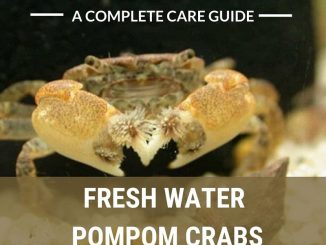

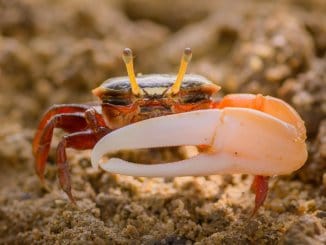
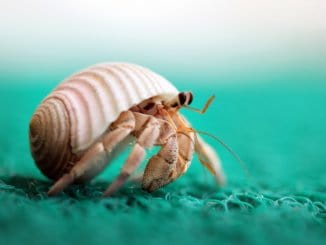
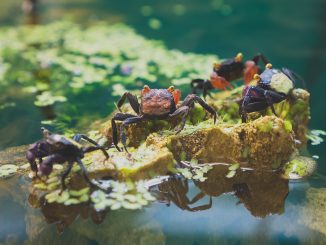

Be the first to comment